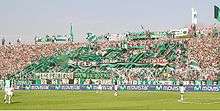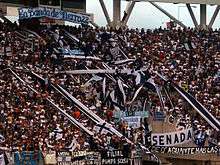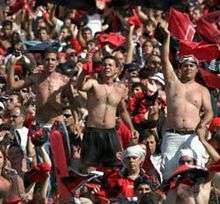Barra brava

Barra brava is a name for organized groups of supporters of football teams in Latin America. Their behavior is similar to European ultras and hooligan groups. It includes standing throughout the match, singing, and other enthusiastic behavior such as waving flags.[1]
The phenomenon originated in Argentina in the 1950s and spread throughout the Americas. Similar groups in Mexico are called porras and torcidas organizadas in Brazil. Barras bravas are common in Uruguay, Bolivia, Peru, Chile and Colombia and have spread to other parts of the world, including the United States.
History
Groups of Argentine fans that stood out for their fervour from the rest of supporters spontaneously began to appear during the 1920s. These groups were labeled Barras by the media; a term that is equivalent to the term gang in Argentina and Uruguay, but that in its original meaning, was used to describe an informal group of people without any relation to crime who meet regularly. One of those groups named La barra de la Goma ("The barra of the rubber"), was created in 1927. They supported the San Lorenzo de Almagro football club. The name comes from the rubber of bike inner tubes (filled with sand, and tied with wire at the ends) to attack rival fans. They would throw objects to their team's goalkeeper to bother him when he should intervene in the game.

The actions of this group were limited to stadiums, during home matches, and they did not follow the team to other cities. They did not intend to provoke violence, as it arose spontaneously usually during games that were difficult for their team, as a way to influence the score through intimidation of rival players and referees with insults and blunt objects. Occasionally they entered the pitch (playing field) and assaulted opposing players. They intimidated rival fans who tried to bother players on their team. At the end of the same decade, a few newspapers described this group as "brave" (Spanish for fierce).
The Barras became a traditional part of the Argentine football crowds and evolved until, in the mid-1950s, they started to receive financing from the football clubs to attend away matches. Their goals expanded to include provoking violence against rival players and fans, repelling police and defending against attacks by rival supporters. They thus became the first organised, violent, football support groups.
Argentine journalist Amílcar Romero stated that, before the appearance of such groups, when a team played away, they were intimidated by rival fans. Barras bravas were a response to this pressure. Each club had its own barra brava, financed by the club. These groups were given tickets and paid travel to the stadiums. Access to these benefits was controlled by the group's leadership. To obtain prestige, the member had to be violent.
In Argentine football it was institutionalised that, if you played away, you were pressured inexorably. Although it was not about barras bravas as we know them today. Home fans pressured you and, police, if was not watching to another place, also pressured you. That had to be compensated with a theory that in the next decade (the 1950s) was rife: to every operating group with a Mystical Ability to produce violence, the only way to counter it is with another minority group, with as much or more mystique to produce violence.
— Amílcar Romero.[2]
In 1958, media and society noted existence of this groups after riots during a match between Vélez Sarsfield and River Plate (at José Amalfitani stadium) at which 19-year-old Alberto Mario Linker, was killed by police (he was hit in the chest by a tear gas grenade) when cops tried to disperse River Plate fans who were causing unrest. Newspaper La Razón denominated River Plate's organised supporter group as a Barra Fuerte (strong gang), differentiating them for the first time from the traditional barras.
Barra brava appeared in Argentine media, in the 1960s, but became a popular term in the 1980s.
Argentina has the most dangerous organized fan groups in the world.[3][4] Through August 2012 Argentine football has experienced 301 hooligan related deaths. Several such deaths and shootings were the result of rival factions within the same clubs.
Characteristics
These groups display and wave flags (that in Argentine football slang are called trapos -cloths-) and umbrellas (with team's colours), and use musical instruments such as bass drums and, since the mid-2000s, trumpets) to accompany their chants. They occupy terraces where viewers must stand. In all-seater stadiums (rare in Argentina and many other Latin American countries), barras bravas stand throughout the match.

The most characteristic flags are shaped like giant strips several meters in length (called trapos largos -long flags- or tirantes -suspenders-), that are deployed from the top of the terrace to the bottom. Barras bravas usually also have a flag with the name of the group.
Traditionally, many members stand upon the crush barriers (paravalanchas -avalanche-stoppers- in Argentine slang) that are placed in terraces to prevent crushing. They hold a "suspender" with one or both hands (this was the purpose to make this flags shaped like strips), or to the body of someone else who is fastened to the flag, or even some supporter who is standing below (on a step).
They start and coordinate every chant and wave the most important and big flags. Barras Bravas always are located in the center of the terrace that occupy.[5] When the group enters the terrace before the match, the center is traditionally left empty by the other fans (even if the terrace it is almost full), showing respect to the barra brava.
Originally these groups were not numerous, violent, or powerful. Over the years, this changed. In some cases the barra brava decided who would be the club's chairman. Since the 1980s and 1990s, hooliganism has grown and some groups engaged in illegal activities such as extorting money from club leadership, players, and hawkers that work at the stadium. They also may participate in drug sales and thefts. They often provide services to political and union leaders who hire them as agitator groups (during rallies and mass meetings, that in Argentina traditionally have people chanting like football crowds, playing drums and even shooting firecrackers), goon squads (clashing with supporters of other political parties, unions or police during demonstrations, protests, rallies and strikes), bodyguards, etc.
They are funded by club leadership, which may give salaries to some members or even a percentage of the profits. Usually they are responsible for stadium security during non-football events.
.jpg)
In Argentina, in the 2000s they faced violent disputes among some of members for control of the group. A large percentage of deaths related to football since that time were related to internal disputes within barras bravas.
The size of the barras brava is generally related to the level of the club's popularity. However, some clubs have big supporter groups even they are not generally popular. This usually occurs when the club has, at least, a relatively high popularity in a neighborhood. Group sizes range from a few dozen to more than 1,000.
See also
| Wikimedia Commons has media related to Ultras. |
References
- ↑ "La Barra Brava: Why US football fans chant in Spanish – BBC News". BBC News. Retrieved 7 May 2016.
- ↑ "Las barras aparecen con la industrialización del fútbol" [Barras appears with industrialization of football]. Página/12. July 13, 2003.
- ↑ Magallón, Enrique López (10 October 2007). "Los hooligans más peligrosos del mundo están en Argentina" [The most dangerous hooligans in the world are in Argentina]. Deutsche Welle. Retrieved 24 November 2014.
- ↑ User, Super. "About Us". www.barra-brava.com. Retrieved 7 May 2016.
- ↑ Kelly, Annie (20 August 2011). "The barra bravas: the violent Argentinian gangs controlling football". The Guardian. ISSN 0261-3077. Retrieved 17 July 2017.